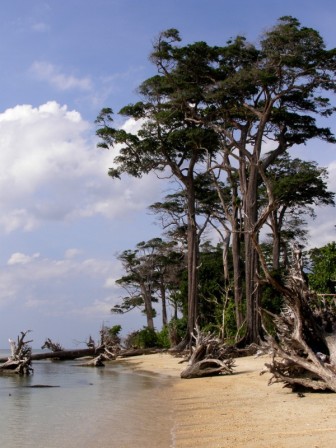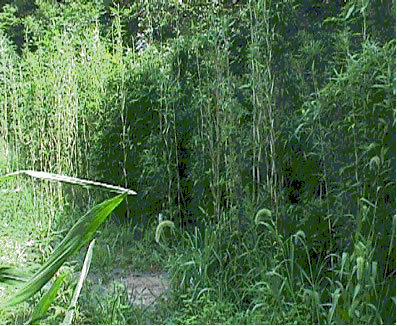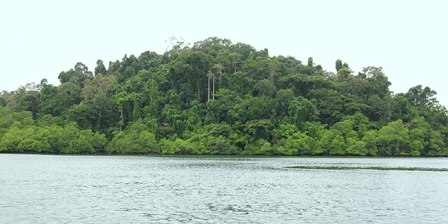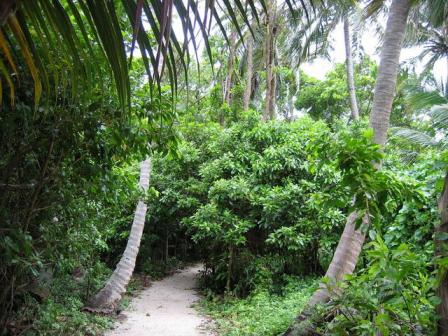GENERAL DESCRIPTION OF FOREST

Andaman Padauk -The State Tree
The tropical rain forests of Andamans can be divided into two main categories.
A group where the forest is mostly a function of the edaphic factors and a group where
the climate is the controlling factor.
These are:
(A) Edaphic Pre-climax forests:
1. Tidal Swamp Forests (Mangrove Forests)
2. Littoral Forests (Beach Forests)
3. Andaman Semi-Evergreen Forests (Low level Evergreen Forests)
4. Southern Hilltop Tropical Evergreen Forests.
(B) Tropical Climatic forests:
1. Andaman Moist Deciduous Forests.
2. Andaman Tropical Evergreen Forests.
3. Giant Evergreen Forests.
Champion and Seth have classified Forest vegetation of these islands into different
types depending upon the nature of soil, tidal influence, moisture retainability
and floristic composition. However, these forest types are not distinctly demarcated,
but on the other hand they imperceptibly merge into one another and form an intimate mixture.
Forest Types Of Middle Andaman (FSI 2009)
SI NO. |
Forest Type |
Area(in SQ KM) |
1 |
Non Forest |
65.48 |
2 |
Giant Evergreen Forest |
0.58 |
3 |
Andaman Tropical Evergreen Forest |
445.59 |
4 |
Southern Hilltop Tropical Evergreen Forest |
19.34 |
5 |
Cane Brakes |
0.00 |
6 |
Wet Bamboo Brakes |
8.72 |
7 |
Andaman Semi - Evergreen Forest |
241.08 |
8 |
Andaman Moist Deciduous Forest |
49.92 |
9 |
Andaman Secondary Moist Deciduous forest |
0.00 |
10 |
Littoral Forest |
0.52 |
11 |
Tidal Swamp Forest (Mangrove Forest) |
110.45 |
12 |
Submontane Hill valley Swamp Forest |
0.00 |
13 |
Plantation |
28.75 |
Total |
970.43 |
Brief description of the forest types are given here under:
1. Giant Evergreen Forest
 Description:
Description: This is the most luxuriant type of forest met with and is the climatic climax where
site conditions are optimum for the tree growth. The top canopy formed by the giant trees,
is almost entirely evergreen and though usually irregular, may locally be more or less complete.
Distribution:This type is present in small areas near the banks of the larger streams,
where soil is deep alluvial. This forest type is now confined to Jarawa Reserve, National
parks, Wildlife Sanctuaries and un-worked natural forests.
Locality Factors: A well distributed annual rainfall of over 3,000mm and a sufficiently retentive soil,
with good internal drainage.
2. Andaman Tropical Evergreen Forest
 Description:
Description: Not so luxuriant as the Giant Evergreen Forest particularly in height
, density and size of the top storey. The canopy is very irregular and incomplete
but is very similar in composition. There are fewer species in the top canopy, deciduous
species rather more frequent and gregarious occurrence is commoner.
Distribution:Throughout the Andamans, typically as caps to the hills with Moist Deciduous
forests on the slopes.
Locality Factors: An annual rainfall of over 3,000mm, well-distributed and sufficiently retentive deep
soil with good internal drainage.
3.Southern Hilltop Tropical Evergreen Forest
 Description:
Description: A more or less inferior edition of the tropical wet evergreen, hardly more than 10m high in
extreme cases.
Distribution: On the exposed upper slopes and tops of hills and some times on steep slopes lower down.
Locality Factors: Exposure to wind and generally less favourable conditions of soil and climate than the main
climax form. Annual rainfall is usually high over 3,500mm and humidity is high during the period of low rainfall.
4.Cane Brakes
 Description:
Description: An impenetrable thorny thicket, sometimes with a few tall trees
standing over it, sometimes without. The stems are typically trailing and may be
60m.or more long. Some species are more or less erect.
Distribution:Throughout the Evergreen and Semi-evergreen climaxes and locally in Moist Deciduous forests.
Locality Factors: Occurs in wet hollows extending outwards to various distances,
becoming more conspicuous with heavier and better distributed rainfall, i.e. in the
wet tropical evergreen. The soil is permanently wet, usually fine clay and very rich in humus.
5. Wet Bamboo Brakes
 Description:
Description: The brakes are often very dense, even if the bamboo grows in
clumps. The bamboo tends to be of a smaller type rather than the big culmed
species.
Distribution:Throughout the Tropical Evergreen tracts of Andamans.
Locality Factors: Wet Bamboo Brakes are usually found along streams or on
badly drained hollows more or less displacing the tree forest, whilst Cane Brakes
replace them in the wettest sites.
6.Andaman Semi - Evergreen Forest
 Description:
Description: A luxuriant type of forest with many giant trees which include both
evergreen and deciduous species, often intimately mixed but frequently in
groups, particularly the evergreens. Climbers are often heavy, bamboo may or
may not be present. Chengappa describes it as the densest forests in Andamans
and terms it “Low Evergreen Forest.”
Distribution:In the main valleys.
Locality Factors: The chief characteristic is the immature alluvial soil sufficiently
old and raised above flood level to be able to progress to the climatic climax, but
with a good well drained sub-soil.
7.Andaman Moist Deciduous Forest
 Description:
Description: There is typically, a somewhat irregular top storey of predominantly
deciduous trees, about 40m or more in height. Many of the trees have very large
girth and are heavily buttressed. Beneath these trees is rather definite second
story of numerous species including some evergreen species. Though most are
deciduous, there is a fairly complete shrubby evergreen under storey, with
patches of bamboos. Climbers are heavy and often include canes.
Distribution:Met with throughout the Andaman Islands covering nearly half the total forest area.
Locality Factors: The underlying rock is chiefly hard, coarse grained sandstone,
with bands of shale and conglomerate and the soil which is often shallow, is a
sandy or clayey loam, light yellow in colour. This type is confined to the hilly
ground and does not extend much above 100metre elevation, where Tropical
Evergreen Forest displaces it. This occurs on flat alluvial ground where the Low
Evergreen Forest is in possession.
8. Andaman Secondary Moist Deciduous forest
 Description:
Description: A more or less even aged pole crop.
Distribution: Worked over areas of the primary type.
Locality Factors: As for the primary type.
9. Littoral Forest
 Description:
Description: The most characteristic species is the tall evergreen Manilkara littoralis,
which often forms an almost pure fringe on sandy beaches and dunes along the sea face.
Scattered smaller evergreen trees occur with fewer deciduous trees and these form the
dominant canopy. There are numerous shrubs and where the undergrowth is light,
maritime grasses and surface creepers are conspicuous binding the sand. In the
depressions, which are swampy usually with saline water, the tidal species are poorly
developed with a dense undergrowth. If the water is fresher, tall grasses (Phragmites) occur.
Distribution:All round the coast wherever a fair width of sandy beach occurs.
Locality Factors: The habitat is an exposed one with pronounced characteristics. The soil is sea-sand often
blown and accumulating in low dunes, with adequate lime from shell fragments but poor in nitrogen and mineral
nutrients. It is very coarse, porous and dry at the surface, but the water table is usually a few feet down.
The water is fresher than expected, but often brackish. Strong winds, often salt laden, act as desiccating
agents with strong insulation and radiation from the bare sand rendering conditions pronouncedly xerophytic.
The temperature is moderate by sea breezes due to the proximity to sea. Rainfall varies with locality; its
influence is mainly seen in the rate at which the formation progresses towards the climatic climax.
10.Tidal Swamp Forest (Mangrove Forest)
 Description:
Description: Typically a closed evergreen forest of moderate height composed of trees specially adapted to survive
on tidal mud, which is permanently wet with saline water and submerged during every tide. Stilt roots are very
typical (notably in Rhizophora), so also leathery leaves and vivipary.
Distribution:In the river deltas along the edge of the waterways and inter-tidal, sheltered muddy coasts.
Locality Factors: The type is found on the mud banks of the delta streams, the tails of islands and over more
extensive areas near the sea face wherever accretion is in progress. It does not develop on the sandy banks at the
sea face. Though some young growth may be found, it passes on to other types without full development in the present.
The ground is flooded daily by salt water and never has time to dry out.
11. Submontane Hill valley Swamp Forest

Highly restricted type with species of little forestry value.
REFERENCES:
Work Plan of Divisional Forest Office, Middle Andaman














 Highly restricted type with species of little forestry value.
Highly restricted type with species of little forestry value.